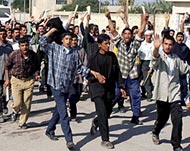Iraqi homes show US how to build
As global warming increases, America and the West may well need the Middle East.

Not just for its plentiful natural resources, but for its buildings.
The public may be unfamiliar with ancient air-conditioning systems such as windcatchers and ice-cooling, but these Middle Eastern technologies are exactly what may be needed in a hotter, more unpredictable climate.
Sue Roaf, professor of architecture at Oxford Brookes University, is co-author of a new book Adapting Buildings and Cities For Climate Change. Her study focuses on the ways buildings have to change as global warming intrudes further on everyday life.
Windcatchers, for example, are ancient ventilation and cooling systems, and are used widely in one very famous city, Baghdad.
“In Baghdad, where the temperature in summer gets up to 50C, windcatchers provide a source of conditioned fresh air by passing it through high, narrow shafts before entering the basement,” says Roaf.
“They cool the internal structure of the house, the walls and floors at night by removing heat from the building, making it cooler internally during the day.”
Kurdish ice
Another system, ice-cooling, was once widely used in western cities and societies. Now largely forgotten, it was first recorded as a coolant more than 4000 years ago. Where? On the plains of northern Iraq. The Ancient Greeks, Romans, Chinese and South Americans all used ice to cool a wide range of items, primarily housing.
The importance of the cooling properties of ice as a social and political tool were also widely noted. An example used by Roaf is the explorer JJ Tschudi who travelled in Peru between 1838 and 1842. He noted that if the ice caravans from the mountains were ever to be interrupted “it might excite popular ferment”.
In northern Iraq, Kurdish communities widely used, and continue to use, natural ice. The ice is stored in pits for use in summer, the original ice having been cut and transported from the mountains of northern Mesopotamia.
Basra riots
“If only the British troops in Iraq had known, they might have been able to fly in Kurdish ice to cool the citizens of Basra in the scorching summer of 2003,” says Roaf.
 |
|
Soaring temperatures added to |
“When the inhabitants of that beleaguered city had no electricity to cool their homes, in temperatures of over 50C, rioting broke out in the streets demonstrating the political importance of cooling.”
Ice houses for cooling were used even in colder countries such as the United Kingdom. The last recorded delivery of Norwegian Wenham ice to the UK was in 1936. But they were also widely used in what is now Iraq, Iran and Syria from ancient times.
“The ice houses were opened on the salad days of summer,” writes Roaf. “To provide ice for the kitchen, the invalid, the ambassador’s salon, the greenhouse and the dining table. ‘Let them unseal the ice of Qatara and make sure the ice is guarded,’ wrote a provincial governor of Northern Assyria to his wife in 1800BCE.”
An American dilemma
One problem in planning housing to cope with global warming is understanding how much the climate will change.
Roaf devotes part of her book to looking at the way the United States has refused to come on board with global warming.
 |
|
Some traditional homes in Iraq |
Instead of planning sustainable housing, it satisfies pent-up demand with cheap, lightweight, easy-to-construct housing creating solid profits for the powerful construction industry. These energy-inefficient houses help to suck up the 50% of the entire US energy demand. The 50% that goes into powering buildings.
Much of this energy goes on air-conditioning which uses up more electricity year on year. Air-conditioning demand is a significant factor in rising US energy use, increasing oil imports and electricity blackouts such as those of August 2003.
“The American building type, with its use of inefficient air-conditioning systems and thin, tight-skinned, unshaded, over-glazed, no-weight buildings is being exported to many countries and being imposed on some, like Iraq,” says Roaf.
This style of cheap housing not only adds to global warming by losing heat but also exposes the American public to future problems.
“The American people will be left, when the lights do go out in extreme weather events, trying to survive in highly vulnerable buildings, highly exposed.”
Leaked memos
This assessment is backed up by the perceived attitude of the US administration to global warming.
 |
|
America has dragged its feet |
“The White House position that mandatory restrictions on emissions should not be countenanced until further research is undertaken is a popular line from the administration,” says Roaf.
“Meanwhile the clock ticks on and more Americans lose their lives to the climate.”
Roaf concludes that this attitude is exemplified by comments from leading Republican consultant Frank Lutz who said the Republicans have “lost the environmental communications battle”.
In a leaked memo, Lutz writes: “Voters believe there is no consensus about global warming within the scientific community. Should the public come to believe that the scientific issues are settled, their view about global warming will change accordingly.”
The latest scientific findings not only proclaim that global warming is happening, but happening significantly faster than was expected. If this is the case, it may not be long before Americans such as Lutz throw out their air-conditioning and look to Iraq for ways to cool their homes.
Adapting Buildings and Cities for Climate Change, Sue Roaf with David Crichton & Fergus Nicol. Published by the Architectural Press www.architecturalpress.com
ISBN 0750659114.